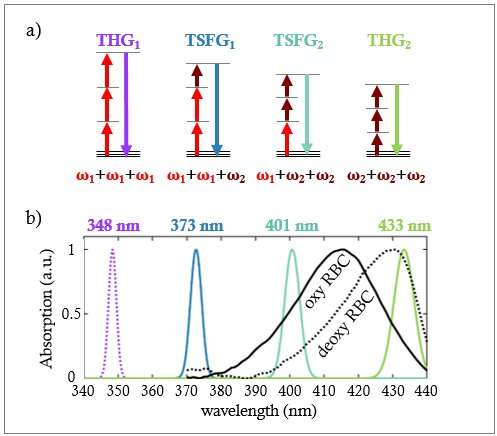(a) Energy diagram of the simultaneous signals processes in color TSFG microscopy, based on third-order combinations of two excitation laser beams. (b) Measured linear absorption spectra of zebrafish RBCs in deoxygenated (dashed line) and oxygenated (solid line) states. The indicated wavelengths are those generated in the case of mixed 1045 and 1300 nm excitation and encompass the Soret absorption band of hemoglobin, enabling spectroscopic measurements. Credit: Júlia Ferrer Ortas, Pierre Mahou, Sophie Escot, Chiara Stringari, Nicolas N. B. David, Laure Bally Cuif, Nicolas Dray, Michel Négrerie, Willy Supatto, Emmanuel Beaurepaire
Cells and tissues rely on the circulation of red blood cells (RBCs) for oxygen supply. Two-photon (2P) microscopy is a reference technique for measuring RBC microcirculation and blood oxygenation using exogenous phosphorescent probes. It is increasingly used to study brain oxygenation and physiology.
However, 2P-based methods face some limitations. Oxygenation measurements based on phosphorescence usually involve pixel times in the tens-of-millisecond range. They probe the blood plasma rather than probing the RBCs directly. Fluorescence-based microcirculation measurements rely on blood labeling or suffer from relatively weak autofluorescence. Moreover, in-depth 2P microscopy is limited by out-of-focus background.
In a new paper published in Light: Science & Application, a team of scientists led by Doctor Emmanuel Beaurepaire from École Polytechnique have demonstrated a unique approach of spectroscopic third harmonic generation (THG) imaging using live zebrafish as a model.
The recent advent of high-power optical parametric amplifiers (OPA) and sources at MHz repetition rates in the 1.3 and 1.7 μm ranges have opened novel perspectives for deep-tissue microscopy using three-photon (3P) excitation. A side benefit of these novel laser technologies is that they also enable efficient label-free imaging based on THG.
THG is a third-order multiphoton imaging modality highlighting interfaces and optical heterogeneities in cells and tissues with applications ranging from cell and developmental biology to neuroscience. THG microscopy is easily combined with 3P fluorescence microscopy for deep-tissue imaging combining both contrast modalities. In live imaging of mice and fish brains, THG has predominantly revealed blood vessels, myelin-rich areas, and skull interfaces.
(a) Resonant TSFG image of isolated human RBCs. (b) 3D rendering of blood vessels segmentation from volumetric color TSFG imaging in the telencephalon of a live adult zebrafish. (c) Left: THG image of the trunk of a 3dpf living zebrafish embryo revealing different structures in addition to RBCs. Right: automated segmentation of RBCs in the dorsal aorta (DA) and posterior cardinal vein (PCV). Credit: Júlia Ferrer Ortas, Pierre Mahou, Sophie Escot, Chiara Stringari, Nicolas N. B. David, Laure Bally Cuif, Nicolas Dray, Michel Négrerie, Willy Supatto, Emmanuel Beaurepaire
Although THG contrast has so far principally been used for structural imaging and as a spatial landmark, it is anticipated that some degree of chemical specificity for absorbing objects could be obtained. A spectroscopic version of THG microscopy could be particularly relevant for probing the absorption properties of non-fluorescent objects. It could provide specific contrast from RBCs and potentially report on their oxygenation state in vivo in a label-free manner.
The development of such a functional imaging approach requires two things. Firstly, it needs the establishment and characterization of the wavelength dependence of THG signals from RBCs. It also needs the implementation of an efficient spectral imaging scheme compatible with the microscopy of moving objects such as flowing RBCs.
The research team developed a novel experimental scheme for spectroscopic imaging based on the simultaneous measurement of THG and third-order sum frequency generation (TSFG) signals. The team investigated several emission wavelengths encompassing the Soret absorption band of hemoglobin. They demonstrated that their approach provides chemically specific contrast.
These results were based on electronic resonance in imaging experiments of isolated red blood cells, zebrafish embryos, and live adult zebrafish brains. The team demonstrated that their method can be used to measure oxygenation dynamics in vivo. There is a wide range of applications in medical technology and supporting future biological studies.
More information: Júlia Ferrer Ortas et al, Label-free imaging of red blood cells and oxygenation with color third-order sum-frequency generation microscopy, Light: Science & Applications (2023). DOI: 10.1038/s41377-022-01064-4
Journal information: Light: Science & Applications
Provided by Chinese Academy of Sciences

























